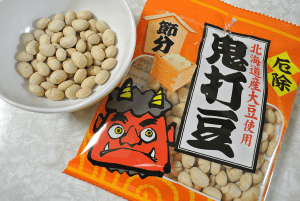Setsubun festival in Feb 3rd. Eat Eho-maki!

Setsubun Festival “Demons out! Happiness in!”
February 3rd is “Setsubun” festival in Japan. (The date is different on each year, but mostly around Feb.3rd) It’s kind of a funny holiday in Japan.
 “Setusbun” literally means “splitting the seasons”. It is the day before the first day of spring, so Setsubun splits between winter and spring. Although it is not designated as a national holiday, the special bean throwing events called “Mame-maki” are held widely to cerebrate Setsubun day. “Mame” means “beans” and “maki” means “scattering”.
“Setusbun” literally means “splitting the seasons”. It is the day before the first day of spring, so Setsubun splits between winter and spring. Although it is not designated as a national holiday, the special bean throwing events called “Mame-maki” are held widely to cerebrate Setsubun day. “Mame” means “beans” and “maki” means “scattering”.
 At home, people throw and scatter roasted soy beans inside and outside their houses while saying,
At home, people throw and scatter roasted soy beans inside and outside their houses while saying,
“Demons OUT! Happiness IN!”
(“Oni-wa-soto, Fuku-wa-uchi” in Japanese.)
Usually one or some of family members wear Demon masks and children throw beans to demons. It’s a lot of fun for children. Many kindergartens held this event for their pupils too.
Why people throw soy beans?
Although there are various theories, it is said that soy beans, in Japanese, “mame” is the same pronunciation of “魔(ma)=evils, 滅(me)=destroy”. Which means to destroy evil spirits.
After throwing the beans, people eat the same number of the beans as their age, and pray for happiness throughout the year. Some say beans age plus 1 would be good for longevity. Why the beans had to be roasted? It is believed that the beans contain the evils of the previous year, and so they are roasted to prevent evils from sprouting.
Some shrines and temples held bean throwing ceremony. Many people gather to get good luck beans which famous public figures throw to the crowd. Famous Bean Throwing Festival in Tokyo is one in Senso-ji temple. As Asakusa is traditional theatrical district, the people who involved in Japanese traditional art or many Japanese comedians appear on a stage every year.
Eho-maki – Lucky rolled sushi.
Some people eat thick rolled sushi, ”Eho-maki” on Setsubun day. ”Eho” means “lucky direction” and “Maki” means “rolled Sushi”. It is regarded to eat up Eho-maki as bringing you good fortune for following year.
 To eat Eho-maki, we have 3 rules.
To eat Eho-maki, we have 3 rules.
The first, face toward the year’s lucky direction. (Each year has each direction. 2018’s direction is south-southeast.)
The second, you need to keep silence while eating, making a wish.
The Third, eat whole. Try not to cut.
Eho-maki is so big that people find it difficult to eat up without cutting. But for this reason people enjoy eating Eho-maki together. Eho-maki is also called “Maru-kaburi-sushi” (swallowing sushi) for the same reason.
The eating of Eho-maki without cutting reflects the idea of forming good relationships.
Eho-maki was originally enjoyed in Kansai(Western) area in Japan. But since convenience stores started selling Eho-maki, it has spread throughout Japan. As I was grown up in Kanto(Eastern) area, I have never heard of Eho-maki when I was a child. But nowadays we see Eho-maki everywhere in Japan around Feb. 3rd. Basic Eho-maki have seven ingredients such as cucumber, sweet omelet, shiitake mushroom and eel after the Seven Deities of Good Luck. There are many varieties these days and you can enjoy the various tastes.
 |
 |
Author Profile

- A national government licensed tour guide in English loves to introduce Japanese life with unique photos📸. Mainly Tokyo🇯🇵 and surroundings.







